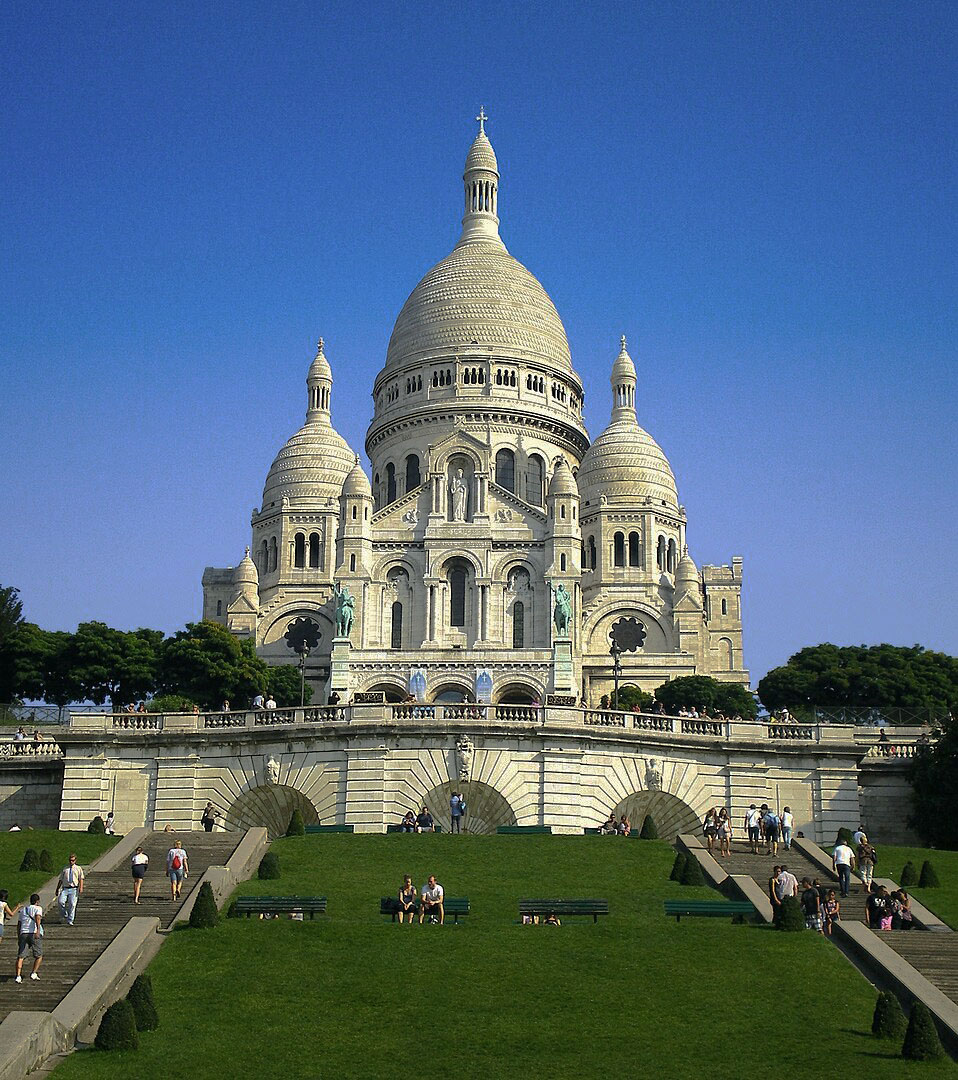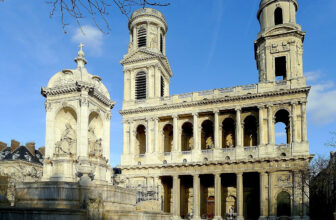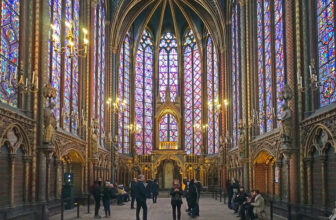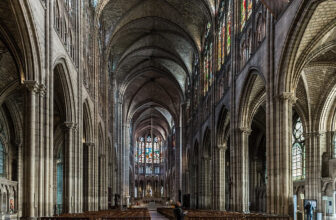
Why is the Basilique du Sacre Coeur de Montmartre Famous?
Perched on the summit of Montmartre, the highest natural point in Paris, stands the Basilica of the Sacred Heart, or Sacre-Coeur, an architectural marvel and spiritual beacon. Its white domes, visible from miles around, have captivated visitors and Parisians alike, making it one of the most iconic landmarks in the City of Light. But what makes the Montmartre Cathedral so famous? Beyond its striking appearance, the basilica’s rich history, cultural significance, and panoramic views all contribute to its enduring allure.
A Hill Steeped in History
Montmartre, literally “Mount of Martyrs”, has a history as dramatic as its steep slopes. The hill owes its name to Saint Denis, the patron saint of France and the first bishop of Paris, who, according to legend, was martyred in the 3rd century. His story of decapitation and miraculous resilience, walking several miles while carrying his severed head, imbued Montmartre with a spiritual aura long before the basilica was built.
Throughout the centuries, Montmartre evolved from a place of religious significance to a rural outpost known for its windmills and vineyards. By the 19th century, it had become a vibrant artists’ enclave, attracting creative luminaries like Pablo Picasso, Vincent van Gogh, and Henri de Toulouse-Lautrec. This artistic legacy, intertwined with the neighborhood’s bohemian spirit, adds to the mystique of Montmartre and its crowning jewel, Sacre-Coeur.
The Origins of Sacre-Coeur
The story of the Basilica of the Sacred Heart begins in the aftermath of the Franco-Prussian War (1870-71), a period marked by national trauma and introspection. France’s defeat in the war, coupled with the violent Paris Commune uprising that followed, left the country searching for solace and redemption. Two devout Catholics, Alexandre Légentil and Hubert Rohault de Fleury, vowed to build a church dedicated to the Sacred Heart of Jesus as an act of penance and a symbol of hope for the nation.
In 1873, the French National Assembly declared Montmartre a public utility site, paving the way for the construction of the basilica. Architect Paul Abadie won the design competition, envisioning a Romano-Byzantine structure that would stand in stark contrast to the Gothic cathedrals typical of France. Construction began in 1875 but would not be completed until 1914, with the basilica consecrated in 1919 after World War I. The timing of its completion, coinciding with a period of healing and renewal, reinforced its role as a spiritual monument.
Architectural Brilliance
Sacre-Coeur’s design is a harmonious blend of artistic influences, drawing inspiration from Romanesque and Byzantine styles. Its gleaming white façade is made of travertine stone, sourced from the Château-Landon quarries in Seine-et-Marne. This unique material secretes calcite upon contact with water, ensuring that the basilica maintains its luminous appearance even after decades of exposure to the elements.
The basilica’s most striking feature is its central dome, which soars to a height of 83 meters (272 feet). Visitors who climb the 300 steps to the top are rewarded with breathtaking, unobstructed views of Paris, stretching as far as 30 kilometers on a clear day. Inside, the basilica’s grandeur continues with intricate mosaics, stained glass windows, and marble sculptures. The apse mosaic, known as “Christ in Majesty,” is one of the largest in the world, depicting Jesus with arms outstretched, surrounded by saints and worshippers.
A Place of Pilgrimage and Worship
Beyond its architectural splendor, Sacre-Coeur is a place of deep spiritual significance. Since its consecration, the basilica has maintained a tradition of perpetual Eucharistic adoration. Day and night, worshippers gather before the Blessed Sacrament in silent prayer, creating an atmosphere of reverence and peace. This unbroken chain of devotion has made Sacre-Coeur a magnet for pilgrims from around the world.
The basilica’s role as a site of prayer and reflection contrasts with the lively energy of Montmartre below, where bustling streets are filled with cafes, art studios, and street performers. This juxtaposition between the sacred and the profane encapsulates the unique character of Montmartre, a neighborhood where spirituality and creativity coexist in harmony.
Cultural Significance and Symbolism
Sacre-Coeur holds a unique place in the cultural and historical consciousness of France. For some, it represents a symbol of national repentance and resilience; for others, it stands as a reminder of the social and political upheavals that shaped modern Paris. Its construction was not without controversy, as it was viewed by some as a conservative reaction to the revolutionary ideals of the Paris Commune. Despite these debates, the basilica has transcended its origins to become a unifying landmark that embodies the enduring spirit of Paris.
Montmartre’s artistic heritage also contributes to the fame of Sacre-Coeur. The hill’s bohemian past lives on in the nearby Place du Tertre, where artists set up easels to paint portraits and landscapes. The basilica itself has inspired countless works of art, literature, and film, further cementing its status as a cultural icon.
The Allure of the View
One of the most compelling reasons for Sacre-Coeur’s fame is its unparalleled vantage point. From its steps and dome, visitors can take in a panoramic view of Paris that rivals that of the Eiffel Tower. The city’s landmarks, the Seine River, Notre-Dame Cathedral, the Louvre, and the distant La Défense skyline, unfold like a living tapestry. At sunset, the view becomes even more magical, as the city is bathed in hues of gold and pink.
This sweeping perspective offers more than just a visual treat; it provides a moment of reflection, a chance to see the city from above and appreciate its beauty and complexity. For many, this experience is as spiritually uplifting as the basilica itself.
Events and Celebrations
Sacre-Coeur is not just a static monument; it is a living, breathing part of Parisian life. Throughout the year, the basilica hosts a variety of religious and cultural events, from Easter and Christmas celebrations to concerts and art exhibitions. One of the most notable events is the annual Fête des Vendanges, or Grape Harvest Festival, which celebrates Montmartre’s winemaking tradition with parades, tastings, and performances. These events draw locals and tourists alike, fostering a sense of community and continuity.
Sacre-Coeur in Popular Culture
The basilica’s distinctive appearance and commanding location have made it a popular backdrop in films, music videos, and literature. From the whimsical streetscapes of “Amélie” to the dramatic vistas in “La Haine,” Sacre-Coeurhas captured the imagination of storytellers and audiences worldwide. Its presence in pop culture reinforces its status as a symbol of Paris, alongside the Eiffel Tower and Notre-Dame.
Preserving the Legacy
As one of the most visited sites in Paris, Sacre-Coeurfaces the challenge of balancing accessibility with preservation. Efforts are continually made to maintain the basilica’s structural integrity and artistic treasures, ensuring that future generations can experience its beauty and significance. Conservation projects, supported by donations and public funding, focus on cleaning the travertine stone, restoring mosaics, and upgrading visitor facilities.
Montmartre itself is also undergoing efforts to preserve its unique character amidst the pressures of modernization and tourism. Local organizations and residents work to maintain the neighborhood’s charm, advocating for the protection of its historic buildings, cobblestone streets, and artistic legacy.
The fame of the Montmartre Cathedral, or Sacre-Coeur, is the result of a perfect confluence of history, architecture, spirituality, and culture. Its striking white domes, perched high above Paris, serve as a beacon of hope and inspiration. Whether one visits for the stunning views, the artistic heritage, or the sense of peace within its walls, Sacre-Coeuroffers an experience that resonates deeply with people from all walks of life.
In a city renowned for its landmarks, Sacre-Coeur stands out not just for its beauty but for its profound connection to the heart and soul of Paris. It is a testament to the enduring power of faith, art, and community, inviting all who visit to reflect, rejoice, and marvel at the wonders of Montmartre and beyond.





